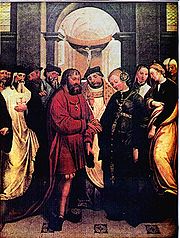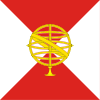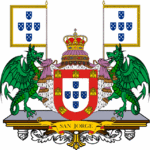- Manuel I of Portugal
-
Manuel I 
17th century painting of Manuel I King of Portugal and the Algarves Reign 25 October 1495—13 December 1521
(26 years, 49 days)Coronation 27 October 1495 in Alcácer do Sal Predecessor John II Successor John III Consort Isabella, Princess of Asturias
Maria of Aragon
Eleanor of AustriaIssue Miguel da Paz, Prince of Portugal and Asturias
John III of Portugal
Isabella, Holy Roman Empress
Beatrice, Duchess of Savoy
Infante Louis, Duke of Beja
Infante Ferdinand, Duke of Guarda and Trancoso
Cardinal-Infante Afonso
Henry of Portugal
Infante Edward, Duke of Guimarães
Infanta Maria, Duchess of ViseuHouse House of Aviz-Beja Father Infante Ferdinand, Duke of Viseu Mother Infanta Beatrice of Portugal Born May 31, 1469
Alcochete, Kingdom of PortugalDied December 13, 1521 (aged 52)
Lisbon, Kingdom of PortugalBurial Jerónimos Monastery, Lisbon, Kingdom of Portugal Religion Roman Catholicism Manuel I (Portuguese pronunciation: [mɐnuˈɛɫ]; Archaic Portuguese: Manoel I, English: Emmanuel I), the Fortunate (Port. o Venturoso), 14th king of Portugal and the Algarves (Alcochete, May 31, 1469 – December 13, 1521 in Lisbon) was the son of Infante Ferdinand, Duke of Viseu, (1433–1470), by his wife, Infanta Beatrice of Portugal. His name is associated with a period of Portuguese civilization distinguished by significant achievements both in political affairs and the arts. In spite of its small size and population in comparison to the great land powers of Europe, it was able to acquire an overseas empire of vast proportions during Manuel's reign.
Contents
Life
Manuel's mother was the granddaughter of King John I of Portugal; his father, Prince Fernando, was the second surviving son of King Edward of Portugal, thus the younger brother of King Afonso V of Portugal. Manuel succeeded his first cousin King John II of Portugal, who was also his brother-in-law, in 1495.
Manuel grew up amidst conspiracies of the Portuguese upper nobility against King John II. He was aware of many people being killed and exiled. His older brother Diogo, the duke of Viseu, was stabbed to death in 1484 by the king himself.
Manuel thus had every reason to worry when he received a royal order in 1493 to present himself to the king, but his fears were groundless: John II wanted to name him heir to the throne, after the death of his son, Prince Afonso, and the failed attempts to legitimise Jorge, Duke of Coimbra, his illegitimate son. As a result of this stroke of luck he was nicknamed the Fortunate.
Manuel would prove a worthy successor to his cousin John II, supporting the Portuguese exploration of the Atlantic Ocean and the development of Portuguese commerce. During his reign, the following was achieved:
- 1498 — Discovery of a maritime route to India by Vasco da Gama
- 1500 — Discovery of Brazil by Pedro Álvares Cabral
- 1505 — Appointment of Francisco de Almeida as the first viceroy of India
- 1503-1515 — Establishment of monopolies on maritime trade routes to the Indian Ocean and Persian Gulf by Afonso de Albuquerque, an admiral, for the benefit of Portugal
All these events made Portugal rich on foreign trade while it formally established a vast overseas empire. Manuel used the wealth to build a number of royal buildings (in the Manueline style) and to attract scientists and artists to his court. Commercial treaties and diplomatic alliances were forged with China and the Persian Empire. The Pope received a monumental embassy from Portugal during his reign designed to draw attention to Portugal's newly-acquired riches to all of Europe.
In Manuel's reign, royal absolutism was the method of government. The Portuguese Cortes (the assembly of the kingdom) only met three times during his reign, always in Lisbon, the king's seat. He reformed the courts of justice and the municipal charters with the crown, modernizing taxes and the concepts of tributes and rights.
Manuel was a very religious man and invested a large amount of Portuguese income to sponsor missionaries to the new colonies, such as Francisco Álvares, and the construction of religious buildings, such as the Monastery of Jerónimos. Manuel also endeavoured to promote another crusade against the Turks.
His relationship with the Portuguese Jews started out well. At the outset of his reign, he released all the Jews who had been made captive during the reign of John II. Unfortunately for the Jews, he decided that he wanted to marry Infanta Isabella of Aragon, then heiress of the future united crown of Spain (widow of his nephew Prince Afonso). Ferdinand and Isabella had expelled the Jews in 1492, and would never marry their daughter to the king of a country that still tolerated their presence.
In December 1496, it was decreed that any Jew who did not convert to Christianity would be expelled from the country. However, those expelled could only leave the country in ships specified by the king. When those who chose expulsion arrived at the port in Lisbon, they were met by clerics and soldiers who used force, coercion, and promises in order to baptize them and prevent them from leaving the country. This period of time technically ended the presence of Jews in Portugal. Afterwards, all converted Jews and their descendants would be referred to as "New Christians", and they were given a grace period of thirty years in which no inquiries into their faith would be allowed; this was later extended to end in 1534.
A popular riot in 1504 ended in the death of two thousand Jews; the leaders of the riot were executed by Manuel.
Isabella died in childbirth in 1498, putting a damper on Portuguese ambitions to rule in Spain, which various rulers had harbored since the reign of King Ferdinand I (1367–1383). Manuel and Isabella's young son Miguel was for a period the heir apparent of Castile and Aragon, but his death in 1500 ended these ambitions. Manuel's next wife, Maria of Aragon, was his first wife's sister, but not the oldest surviving one. That was rather Joanna of Castile, who had issue.
In 1506 the Pope Julius II gave Manuel I a Golden Rose. Later in 1514 Pope Leo X also gave Manuel I a second Golden Rose. Manuel I became the first individual to receive more than one Golden Rose.
The Jerónimos Monastery in Lisbon houses Manuel's tomb. His son João succeeded him as king.
Ancestry
Ancestors of Manuel I of Portugal 16. Peter I of Portugal (= 24) 8. John I of Portugal (= 12, 28) 17. Teresa Lourenço (= 25) 4. Edward of Portugal 18. John of Gaunt, 1st Duke of Lancaster (= 26) 9. Philippa of Lancaster (= 13) 19. Blanche of Lancaster (= 27) 2. Infante Ferdinand, Duke of Viseu 20. John I of Castile 10. Ferdinand I of Aragon 21. Eleanor of Aragon 5. Eleanor of Aragon 22. Sancho Alfonso, 1st Count of Alburquerque 11. Eleanor of Alburquerque 23. Beatrice of Portugal 1. Manuel I of Portugal 24. Peter I of Portugal (= 16) 12. John I of Portugal (= 8, 28) 25. Teresa Lourenço (= 17) 6. Infante John, Lord of Reguengos de Monsaraz 26. John of Gaunt, 1st Duke of Lancaster (= 18) 13. Philippa of Lancaster (= 9) 27. Blanche of Lancaster (= 19) 3. Infanta Beatrice of Portugal 28. John I of Portugal (= 8, 12) 14. Afonso, 1st Duke of Braganza 29. Inês Pires Esteves 7. Isabella of Braganza 30. Nuno Álvares Pereira 15. Beatriz Pereira de Alvim 31. Leonor de Alvim Marriages and descendants
Portuguese royalty
House of Aviz-BejaManuel I Children include Miguel da Paz, Prince of Portugal and of Asturias John III Isabella, Holy Roman Empress Beatrice, Duchess of Savoy Louis, Duke of Beja Ferdinand, Duke of Guarda and Trancoso Cardinal-Infante Afonso Henry Edward, Duke of Guimarães Maria, Lady of Viseu Grandchildren include Anthony (illegitimate) Maria, Duchess of Parma and Piacenza Catherine, Duchess of Braganza Great-Great-Grandchildren include John IV John III Children include Maria Manuela, Princess of Portugal and of Asturias John Manuel, Prince of Portugal Grandchildren include Sebastian Sebastian Henry Anthony Negotiations for a marriage between Manuel and Elizabeth of York in 1485 were halted by the death of Richard III of England. He went on to marry three times. His first wife was Isabella of Aragon, princess of Spain and widow of the previous Prince of Portugal Afonso. Next he married another princess of Spain, Maria of Aragon (his first wife's sister), then Eleanor of Austria, a niece of his first two wives who Francis I of France after Manuel's death.
Name Birth Death Notes By Isabella of Asturias (October 2, 1470–August 28, 1498; married in 1497) Miguel da Paz, Prince of Portugal August 23, 1498 July 19, 1500 Prince of Portugal, Prince of Asturias and heir to both Portugal and Spain. By Maria of Aragon (June 19, 1482–March 7, 1517; married in 1501) João, Prince of Portugal (John) June 6, 1502 June 11, 1557 Who succeeded him as John III, 15th King of Portugal. Infanta Isabel (Elizabeth) October 24, 1503 May 1, 1539 Holy Roman Empress by marriage to Charles V, Holy Roman Emperor. Infanta Beatriz (Beatrice) December 31, 1504 January 8, 1538 Duchess of Savoy by marriage to Charles III, Duke of Savoy. Infante Luís (Louis) March 3, 1506 November 27, 1555 Unmarried but had illegitimate descendants, one of them being António, Prior of Crato, a claimant of the throne of Portugal in 1580 (See: Struggle for the throne of Portugal). Infante Fernando (Ferdinand) June 5, 1507 November 7, 1534 Duke of Guarda and Trancoso. Married Guiomar (Guyomare) Coutinho, 5th Countess of Marialva and 3rd Countess of Loulé (?-1534). No surviving issue. Infante Afonso (Alphonse) April 23, 1509 April 21, 1540 Cardinal of the Kingdom. Infanta Maria (Mary) 1513 1513 Infante Henrique (Henry) January 31, 1512 January 31, 1580 Cardinal of the Kingdom who succeeded his grandnephew, King Sebastian (Manuel I's great-grandson), as Cardinal Henry, 17th King of Portugal. His death triggered the struggle for the throne of Portugal. Infante Duarte (Edward) October 7, 1515 September 20, 1540 Duke of Guimarães and great-grandfather of John IV of Portugal. Married Isabel of Braganza, daughter of Jaime, Duke of Braganza. Infante António (Anthony) September 9, 1516 1516 By Eleanor of Austria (November 15, 1498–February 25, 1558; married in 1518) Infante Carlos (Charles) February 18, 1520 April 14, 1521 Infanta Maria (Mary) June 18, 1521 October 10, 1577 Unmarried. See also
- Manueline, an architectural style
Manuel I of PortugalCadet branch of the House of AvizBorn: 31 May 1469 Died: 13 December 1521Regnal titles Preceded by
John IIKing of Portugal and the Algarves
1495–1521Succeeded by
John IIIPortuguese royalty Preceded by
AfonsoPrince of Portugal
1491–1495Succeeded by
JaimeInfantes of Portugal The generations indicate descent form Afonso I, and continues through the House of Aviz, the House of Bourbon through Isabella of Portugal, and the House of Braganza through Infanta Catherine, Duchess of Braganza.1st Generation 2nd Generation Infante Raimundo • Afonso II • Infante Pedro, Count of Urgell • Infante Fernando, Count of Flanders • Infante Henrique3rd Generation 4th Generation 5th Generation Infante Afonso, Lord of Leiria • Afonso IV6th Generation 7th Generation Infante Luís • Ferdinand I • Infante Afonso • Infante João, Duke of Valencia de Campos • Infante Dinis, Lord of Cifuentes8th Generation Infante Pedro • Infante Afonso • Infante Afonso • Edward I • Infante Pedro, 1st Duke of Coimbra • Infante Henrique, 1st Duke of Viseu • Infante João, Lord of Reguengos de Monsaraz • Infante Fernando, the Saint Prince9th Generation Infante Miguel^ • Infante Diogo, Constable of Portugal • Infante João • Peter V, King of Aragon • Infante João, Prince of Antioch • Afonso V • Cardinal-Infante Jaime • Infante Fernando, 2nd Duke of Viseu • Infante Duarte10th Generation Infante João, 3rd Duke of Viseu • Infante Diogo, 4th Duke of Viseu • João, Prince of Portugal • John II • Infante Duarte • Infante Diniz • Infante Simião • Infante Afonso • Manuel I11th Generation Afonso, Prince of Portugal • Infante João • Miguel da Paz, Prince of Portugal and Asturias^ • John III • Infante Luís, 5th Duke of Beja • Infante Fernando, Duke of Guarda and Trancoso • Cardinal-Infante Afonso • Henry, The Cardinal-King • Infante Duarte, 4th Duke of Guimarães • Infante António • Infante Carlos12th Generation Afonso, Prince of Portugal • Manuel, Prince of Portugal • Filipe, Prince of Portugal • Infante Dinis • John Manuel, Prince of Portugal • Infante António13th Generation 14th Generation 15th Generation Balthasar Charles, Prince of Portugal and Asturias* • Infante Francisco Fernando* • Teodósio, 1st Prince of Brazil • Afonso VI • Peter II16th Generation João, 3rd Prince of Brazil • John V • Infante Francisco, 7th Duke of Beja • Infante António • Infante Manuel, Count of Ourém •17th Generation 18th Generation none19th Generation 20th Generation Francisco António, 8th Prince of Beira • Peter I of Brazil & IV of Portugal • Miguel I • Infante Pedro Carlos* • Infante Carlos José Antonio*21st Generation 22nd Generation Pedro V • Luís I • Infante João, 8th Duke of Beja • Infante Fernando • Infante Augusto, 3rd Duke of Coimbra • Infante Leopoldo • Infante Eugénio Maria • Infante Miguel, 6th Duke of Viseu • Infante Francisco José • Infante Duarte Nuno, 25th Duke of Braganza23rd Generation Carlos I • Afonso, Prince Royal and 3rd Duke of Porto • Infante Duarte Pio, Duke of Braganza • Infante Miguel, Duke of Viseu • Infante Henrique, Duke of Coimbra24th Generation Luís Filipe, Prince Royal • Manuel II • Infante Dinis, Duke of Porto • Infante Afonso, Prince of Beira •^also an infante of Castile and León, Aragon, Sicily and Naples, *also an infante of Spain, **claimant infante, ^^only prince or infante by marriageCategories:- Portuguese monarchs
- Roman Catholic monarchs
- House of Aviz
- Knights of the Garter
- Knights of the Golden Fleece
- 1469 births
- 1521 deaths
- Recipients of the Golden Rose
- Manueline architecture
- Portuguese maritime history
- Princes of Portugal
- Portuguese infantes
- Dukes of Beja
Wikimedia Foundation. 2010.





